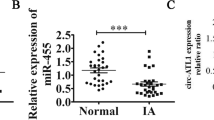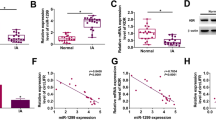Abstract
Background
Proliferation and apoptosis of vascular smooth muscle cells (VSMCs) are linked to intracranial aneurysm (IA) formation and progression. Long antisense noncoding RNA in the INK4 locus (ANRIL) has been reported to regulate VSMC functions in several cardiovascular diseases. However, little is known about how ANRIL influences VSMC proliferation and apoptosis during IA pathogenesis.
Methods
The expression level of ANRIL in the plasma and arterial wall tissues of patients with IA was detected by real-time quantitative polymerase chain reaction. The functional role of ANRIL in the regulation of VSMC proliferation and apoptosis and its downstream regulatory mechanism were determined using Cell Counting Kit 8, immunofluorescence, terminal-deoxynucleotidyl transferase-mediated UTP nick end labeling, western blotting, luciferase reporter assay, and RNA immunoprecipitation assay.
Results
ANRIL was downregulated in the plasma and arterial wall tissues of patients with IA, when compared with control groups. Overexpression of ANRIL significantly promoted VSMC proliferation and blocked cell apoptosis. Mechanistic studies demonstrated that ANRIL directly bound to microRNA-7 (miR-7) and that overexpression of miR-7 overturned the increased cell proliferation and decreased cell apoptosis, which was induced by ANRIL restoration. Besides, further study showed that ANRIL positively regulated fibroblast growth factor 2 (FGF2) expression via targeting miR-7.
Conclusions
These results suggested that ANRIL affects VSMC proliferation and apoptosis via regulation of the miR-7/FGF2 pathway in IA, which provided a potential novel strategy for the treatment of IA.





Similar content being viewed by others
References
Wei L, Wang Q, Zhang Y, et al. Identification of key genes, transcription factors and microRNAs involved in intracranial aneurysm. Mol Med Rep. 2018;17(1):891–7.
Turan N, Heider RA, Zaharieva D, et al. Sex differences in the formation of intracranial aneurysms and incidence and outcome of subarachnoid hemorrhage: review of experimental and human studies. Transl Stroke Res. 2016;7(1):12–9.
Luo J, Jin H, Jiang Y, et al. Aberrant expression of microRNA-9 contributes to development of intracranial aneurysm by suppressing proliferation and reducing contractility of smooth muscle cells. Med Sci Monit. 2016;22:4247–53.
Ayling OGS, Ibrahim GM, Alotaibi NM, Gooderham PA, Macdonald RL. Anemia after aneurysmal subarachnoid hemorrhage is associated with poor outcome and death. Stroke. 2018;49(8):1859–65.
Wiebers DO, Piepgras DG, Meyer FB, et al. Pathogenesis, natural history, and treatment of unruptured intracranial aneurysms. Mayo Clin Proc. 2004;79(12):1572–83.
Miyata T, Minami M, Kataoka H, et al. Osteoprotegerin prevents intracranial aneurysm progression by promoting collagen biosynthesis and vascular smooth muscle cell proliferation. J Am Heart Assoc. 2020;9(17):e015731.
Li S, Shi Y, Liu P, et al. Metformin inhibits intracranial aneurysm formation and progression by regulating vascular smooth muscle cell phenotype switching via the AMPK/ACC pathway. J Neuroinflammation. 2020;17(1):191.
Cao Y, Wang J, Lu X, et al. Construction of a long noncoding RNAmediated transcription factor and gene regulatory triplet network reveals global patterns and biomarkers for ischemic stroke. Int J Mol Med. 2020;45(2):333–42.
Cai J, Shangguan S, Li G, et al. Knockdown of lncRNA Gm11974 protect against cerebral ischemic reperfusion through miR-766-3p/NR3C2 axis. Artif Cells Nanomed Biotechnol. 2019;47(1):3847–53.
Zhang X, Liu Z, Shu Q, et al. LncRNA SNHG6 functions as a ceRNA to regulate neuronal cell apoptosis by modulating miR-181c-5p/BIM signalling in ischaemic stroke. J Cell Mol Med. 2019;23(9):6120–30.
Gao G, Zhang Y, Yu J, et al. Long non-coding RNA MALAT1/microRNA-143/VEGFA signal axis modulates vascular endothelial injury-induced intracranial aneurysm. Nanoscale Res Lett. 2020;15(1):139.
Wu C, Song H, Wang Y, et al. Long non-coding RNA TCONS_00000200 as a non-invasive biomarker in patients with intracranial aneurysm. Biosci Rep. 2019;39(11):2019.
Man H, Bi W. Expression of a novel long noncoding RNA (lncRNA), GASL1, is downregulated in patients with intracranial aneurysms and regulates the proliferation of vascular smooth muscle cells in vitro. Med Sci Monit. 2019;25:1133–9.
Liu X, Li S, Yang Y, et al. The lncRNA ANRIL regulates endothelial dysfunction by targeting the let-7b/TGF-betaR1 signalling pathway. J Cell Physiol 2021;236(3):2058–69.
Huang T, Zhao HY, Zhang XB, et al. LncRNA ANRIL regulates cell proliferation and migration via sponging miR-339-5p and regulating FRS2 expression in atherosclerosis. Eur Rev Med Pharmacol Sci. 2020;24(4):1956–69.
Dai W, Lee D. Interfering with long chain noncoding RNA ANRIL expression reduces heart failure in rats with diabetes by inhibiting myocardial oxidative stress. J Cell Biochem. 2019;120(10):18446–56.
Chen Y, Li G, Fan H, et al. CDKN2BAS gene polymorphisms and the risk of intracranial aneurysm in the Chinese population. BMC Neurol. 2017;17(1):214.
Pasmant E, Sabbagh A, Vidaud M, Bieche I. ANRIL, a long, noncoding RNA, is an unexpected major hotspot in GWAS. FASEB J. 2011;25(2):444–8.
Li H, Wang W, Zhang L, et al. Identification of a long noncoding RNA-associated competing endogenous RNA network in intracranial aneurysm. World Neurosurg. 2017;97:684-92.e4.
Li H, Yue H, Hao Y, et al. Expression profile of long noncoding RNAs in human cerebral aneurysms: a microarray analysis. J Neurosurg. 2017;127(5):1055–62.
Shu L, Zhang W, Huang C, et al. lncRNA ANRIL protects H9c2 cells against hypoxia-induced injury through targeting the miR-7-5p/SIRT1 axis. J Cell Physiol. 2020;235(2):1175–83.
Wang K, Wang X, Lv H, et al. Identification of the miRNA-target gene regulatory network in intracranial aneurysm based on microarray expression data. Exp Ther Med. 2017;13(6):3239–48.
Futami K, Yamashita J, Tachibana O, et al. Basic fibroblast growth factor may repair experimental cerebral aneurysms in rats. Stroke. 1995;26(9):1649–54.
Wang Y, Wang C, Yang Q, Cheng YL. ANXA3 silencing ameliorates intracranial aneurysm via inhibition of the JNK signaling pathway. Mol Ther Nucleic Acids. 2019;17:540–50.
Che J. Molecular mechanisms of the intracranial aneurysms and their association with the long noncoding ribonucleic acid ANRIL—a review of literature. Neurol India. 2017;65(4):718–28.
Furukawa H, Wada K, Tada Y, et al. Mast cell promotes the development of intracranial aneurysm rupture. Stroke. 2020;51(11):3332–39.
Fan W, Liu Y, Li C, et al. microRNA-331-3p maintains the contractile type of vascular smooth muscle cells by regulating TNF-alpha and CD14 in intracranial aneurysm. Neuropharmacology. 2020;164:107858.
Morel S, Karol A, Graf V, et al. Sex-related differences in wall remodeling and intraluminal thrombus resolution in a rat saccular aneurysm model. J Neurosurg. 2019;2019:1–14.
He X, Lian Z, Yang Y, et al. Long non-coding RNA PEBP1P2 suppresses proliferative VSMCs phenotypic switching and proliferation in atherosclerosis. Mol Ther Nucleic Acids. 2020;22:84–98.
Cai Z, Huang J, Yang J et al. LncRNA SENCR suppresses abdominal aortic aneurysm formation by inhibiting smooth muscle cells apoptosis and extracellular matrix degradation. Bosn J Basic Med Sci. 2021;21(3):323–30.
Zhang X, Wu H, Mai C, Qi Y. Long noncoding RNA XIST/miR-17/PTEN axis modulates the proliferation and apoptosis of vascular smooth muscle cells to affect stanford type A aortic dissection. J Cardiovasc Pharmacol. 2020;76(1):53–62.
Florian IA, Timis TL, Ungureanu G, et al. Deciphering the vascular labyrinth: role of microRNAs and candidate gene SNPs in brain AVM development—literature review. Neurol Res. 2020;2020:1–12.
Tan P, Guo YH, Zhan JK, et al. LncRNA-ANRIL inhibits cell senescence of vascular smooth muscle cells by regulating miR-181a/Sirt1. Biochem Cell Biol. 2019;97(5):571–80.
Congrains A, Kamide K, Katsuya T, et al. CVD-associated non-coding RNA, ANRIL, modulates expression of atherogenic pathways in VSMC. Biochem Biophys Res Commun. 2012;419(4):612–6.
Li DS, Ainiwaer JL, Sheyhiding I, Zhang Z, Zhang LW. Identification of key long non-coding RNAs as competing endogenous RNAs for miRNA-mRNA in lung adenocarcinoma. Eur Rev Med Pharmacol Sci. 2016;20(11):2285–95.
Funding
Not applicable.
Author information
Authors and Affiliations
Contributions
Yangchun Hu designed, supervised the research, and participated in the reviewing of the manuscript. Weiwei Chen guaranteed the integrity of the entire study and participated in writing the manuscript. Chao Li performed the literature research. Xiaojian Wang, Jing Luo and Baochun Cheng performed the experimental studies, data analysis, and statistical analysis. All authors read and approved the final manuscript.
Corresponding author
Ethics declarations
Conflicts of interest
The authors declare that they have no conflicts of interest.
Ethical approval/informed consent
Research protocol was approved by the First Affiliated Hospital of Anhui Medical University. Written informed consent was obtained from all participants.
Additional information
Publisher's Note
Springer Nature remains neutral with regard to jurisdictional claims in published maps and institutional affiliations.
Rights and permissions
About this article
Cite this article
Hu, Y., Chen, W., Li, C. et al. LncRNA ANRIL Facilitates Vascular Smooth Muscle Cell Proliferation and Suppresses Apoptosis via Modulation of miR-7/FGF2 Pathway in Intracranial Aneurysms. Neurocrit Care 36, 106–115 (2022). https://doi.org/10.1007/s12028-021-01262-9
Received:
Accepted:
Published:
Issue Date:
DOI: https://doi.org/10.1007/s12028-021-01262-9




